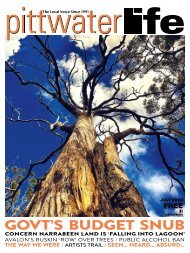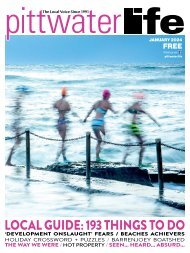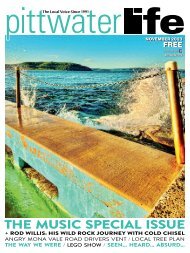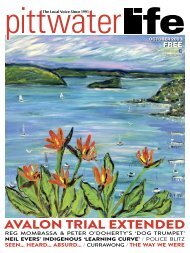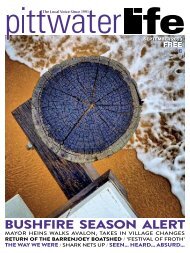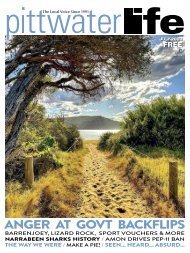Pittwater Life March 2017 Issue
The Soapbox Issue - Local Leaders Have Their Say. Great Scots. It's On For Young & Old.
The Soapbox Issue - Local Leaders Have Their Say. Great Scots. It's On For Young & Old.
Create successful ePaper yourself
Turn your PDF publications into a flip-book with our unique Google optimized e-Paper software.
If you are having trouble falling asleep or<br />
not getting enough quality sleep and feeling<br />
sleepy during the day talk to your doctor.<br />
Sometimes certain medications can<br />
affect your sleep; also some sleep<br />
disorders such as insomnia and obstructive<br />
sleep apnoea are more common in the<br />
elderly but with diagnosis and care they<br />
can be treated and even prevented.<br />
People tend to fall<br />
off the exercise<br />
bandwagon with the<br />
arrival of the kids<br />
and/or heavy work<br />
commitments through<br />
our 30s and 40s, says<br />
Warwick Sargeant of<br />
Avalon Physiotherapy.<br />
“Bad patterns tend to<br />
extend into our senior<br />
years when some of us<br />
have already picked up a<br />
little blood pressure and<br />
cholesterol and obesity<br />
and maybe even Type 2<br />
Diabetes,” he said.<br />
“We see a lot of people<br />
who have an ongoing<br />
niggling injury which<br />
is certainly treatable<br />
by us in the short term<br />
but more importantly a<br />
symptom in itself of a<br />
larger issue such as the<br />
loss of general condition<br />
or fitness… especially<br />
in the postural muscle<br />
groups of the spine and<br />
pelvis.<br />
“We always assist our<br />
patients with a specific<br />
solution but include<br />
a return to a general<br />
exercise as a very<br />
important part of the<br />
total resolution,” he said.<br />
Find something you enjoy<br />
Warwick stressed: “It<br />
doesn’t really matter<br />
what the form of exercise<br />
is.”<br />
“The two most<br />
important factors<br />
are that you somewhat<br />
enjoy the activity and<br />
that you actually keep<br />
doing it... if you don’t<br />
enjoy it, you won’t.”<br />
Walking, swimming,<br />
cycling, playing ball<br />
sports like tennis,<br />
kayaking, aquarobics,<br />
aerobics, circuit training,<br />
Pilates, Tai Chi, yoga all<br />
have benefits to your<br />
health if you keep them<br />
up, he said.<br />
“Combinations of these<br />
give variety and if you<br />
can alternate between<br />
a leg-based fitness<br />
(walking, cycling) and<br />
arm-based (swimming,<br />
racquet sports) then you<br />
tend to get more all-over<br />
muscle group coverage.”<br />
Warwick says five<br />
important things to<br />
keep in mind are:<br />
You have to puff a<br />
1. bit. “Exercise at a rate<br />
or a speed that makes<br />
you a little breathless. By<br />
that I mean you can still<br />
maintain a conversation<br />
but you pant between<br />
phrases. Try to exercise<br />
for 20 to 25 mins.”<br />
Use the local terrain<br />
2. and/facilities.<br />
“Choose interesting<br />
local walks, use the local<br />
pool or <strong>Pittwater</strong> to swim<br />
or kayak on. So it is<br />
handy and you have no<br />
excuse for not returning.”<br />
Keep good posture<br />
3. throughout. “Even<br />
though you may not be<br />
doing a specific back<br />
exercise, by keeping<br />
good erect posture<br />
throughout the activity<br />
you will be toning those<br />
muscles adjacent to<br />
your spine without even<br />
trying.”<br />
Don’t push yourself<br />
4. too hard or you<br />
won’t return.<br />
Think about what<br />
5. you used to like<br />
doing when you were at<br />
high school and it will<br />
help you select a fun<br />
activity.<br />
Health & Wellbeing<br />
Get ‘back’ on track<br />
Of all of the predictors of back pain<br />
and degeneration there is one that<br />
has a significantly larger amount<br />
of evidence, that being sedentary<br />
lifestyle – in other words, not<br />
moving your body enough, says<br />
Doctor of Chiropractic, Sam Garner<br />
from Avalon Beach Chiropractic &<br />
Wellness.<br />
“Our body was designed to move<br />
through the full range of motion of all<br />
of its joints; when we do not deliver<br />
this movement to the body, the joints<br />
begin to stiffen up and over time it<br />
can lead to permanent loss of motion<br />
and degeneration,” Sam said.<br />
He said when patients attend<br />
a Chiropractor, treatment such<br />
as mobilisation, chiropractic<br />
adjustments, dry needling, massage<br />
and rehabilitative exercises and<br />
stretches are given to alleviate pain<br />
and restore normal motion.<br />
“It is essential after treatment in<br />
order to prevent problems coming<br />
back (or occurring in the first place)<br />
to regularly move our bodies through<br />
their full range of motion.<br />
“For elderly members of our<br />
community with degenerative<br />
conditions I recommend water-based<br />
activity which may be as simple as<br />
walking back and forth in the water,<br />
swimming or water aerobics – due<br />
to the buoyancy in water there is<br />
minimal pressure on the joints while<br />
strengthening the surrounding<br />
muscles and allowing healthy<br />
movement.<br />
“Other gentle activity such as<br />
Tai Chi, gentle yoga and specific<br />
exercises directed by a Chiropractor<br />
or other health care professional are<br />
recommended,” he said.<br />
MARCH <strong>2017</strong> 37




